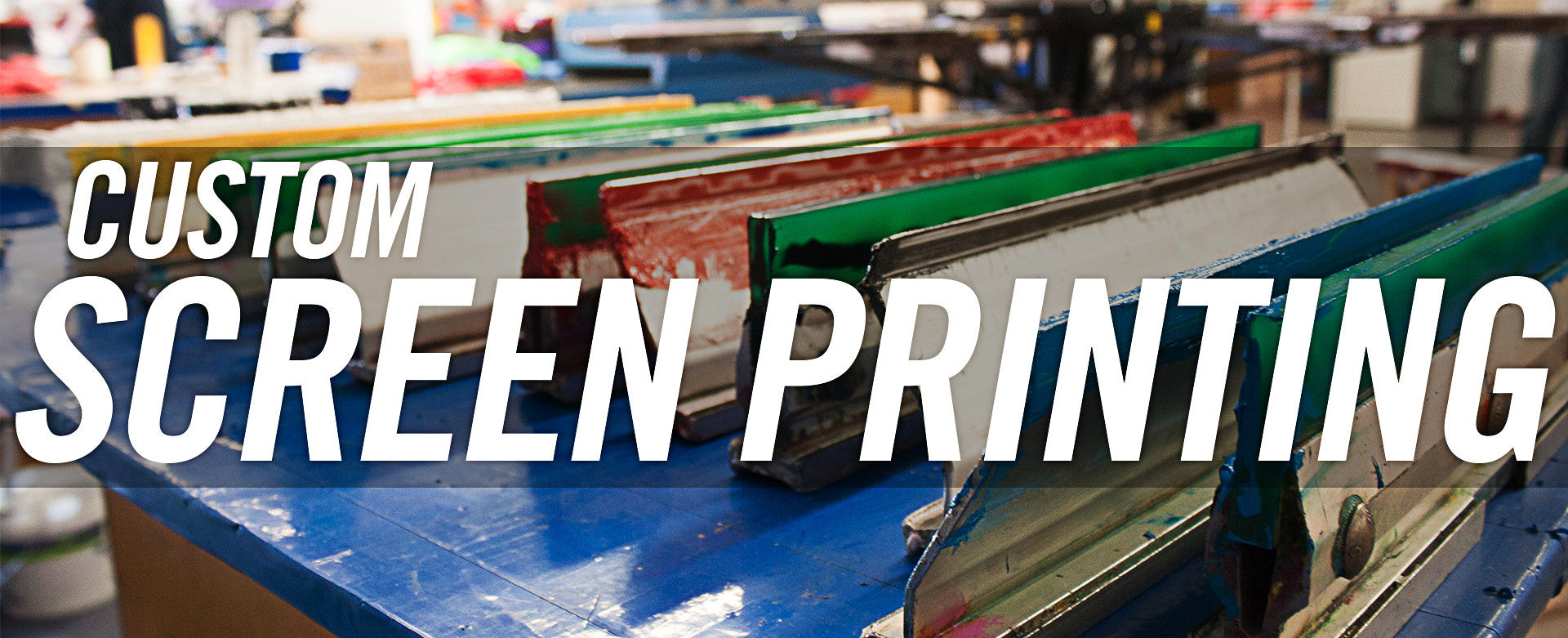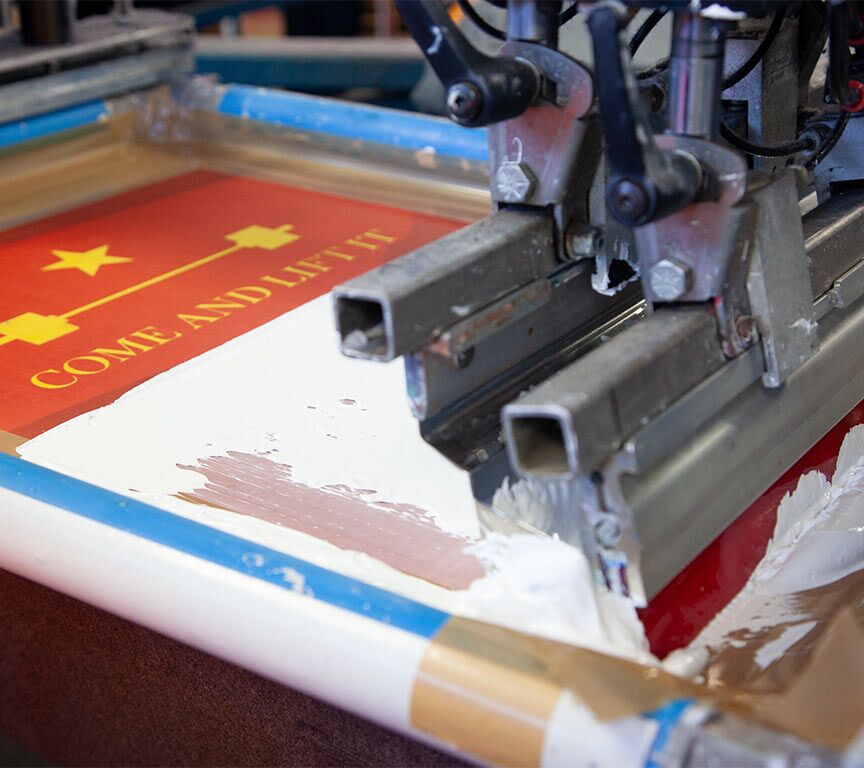Professional Screen Printing Kit for Custom Apparel
Professional Screen Printing Kit for Custom Apparel
Blog Article
Display Printing Uncovered: Everything You Need to Know Concerning Tee and Garment Printing Strategies
If you have actually ever questioned just how those dynamic styles finish up on your preferred tees, you're in the right location. Screen printing is an interesting approach that combines art with method, providing countless opportunities for imagination. Understanding the fundamentals, from tools to ink selections, can considerably impact your results. All set to check out the necessary elements that make screen publishing an art form? Allow's reveal the details that can raise your jobs.
The Basics of Display Printing: Exactly How It Works
When you plunge right into screen printing, you'll find it's both an art and a scientific research. At its core, screen printing entails creating a stencil, or screen, that enables ink to pass with just in certain areas.
Position the screen over the textile, after that use a squeegee to press ink via the display onto the garment. Each step is essential, and mastering them will raise your display printing abilities, transforming simple garments into unique, expressive pieces.
Kinds of Display Printing Techniques
As soon as you grasp the fundamentals of screen printing, it's time to explore the various methods that can raise your styles. One prominent technique is standard screen printing, where ink is pressed via a stenciled display. This method is great for bold, lively colors. After that there's water-based ink printing, which supplies a softer feel and is environment-friendly, but it needs a different approach to treating.
If you're intending for great details, think about discharge printing. This technique removes dye from the textile, leaving a soft, vintage appearance. One more alternative is plastisol printing, recognized for its sturdiness and vibrant colors, making it a preferred for several brand names. Experiment with halftone printing to create gradient results and complex designs. Each technique has its unique charm, so do not hesitate to try them out to find what matches your style best!
Essential Devices for Display Printing
To accomplish magnificent outcomes in display printing, having the appropriate equipment is basic. You'll need a durable screen printing frame, which holds the mesh that moves your style onto the garment. Next, invest in top notch mops; these are essential for applying ink evenly throughout the screen.
Picking the Right Inks and Materials
When choosing inks and products for display printing, you need to think about the kind of ink that works ideal for your job. Believe regarding textile compatibility to assure your designs look excellent and last lengthy. Explore green ink alternatives to make your printing process extra lasting.
Sorts Of Display Inks
Choosing the ideal display ink is vital for attaining dynamic, sturdy prints that meet your project's requirements. There are a number of kinds of display inks to examine. Plastisol ink is popular for its adaptability and convenience of usage, providing excellent color opacity on dark materials. Water-based ink, on the various other hand, offers a softer feel and is environmentally friendly, making it perfect for those looking to lessen their environmental influence. Release inks eliminate color from the textile, resulting in a soft, vintage appearance however require specific handling. Specialty inks, such as glow-in-the-dark or metal, can include special impacts to your designs. Assess your project demands and select the ink that aligns best with your wanted outcome.

Textile Compatibility Factors To Consider
Comprehending textile compatibility is important for attaining high-quality screen prints, especially considering that various products respond distinctively to various inks. Constantly evaluate your inks on example material to guarantee they stick appropriately and maintain shade stability. Additionally, maintain in mind that textile weight and structure can impact the last end result, so selecting the appropriate ink and material combination is essential for your job's success.
Eco-Friendly Ink Options
Eco-friendly inks are ending up being a prominent option for display printers who wish to minimize their environmental impact while keeping top quality. When choosing inks, take into consideration water-based inks, which are less damaging and less complicated to tidy up contrasted to standard solvents. These inks bond well with fabrics, providing dynamic results without toxic chemicals. You may additionally check out eco-solvent inks that make use of fewer volatile natural substances (VOCs), making them a much safer choice for both your wellness and the earth.
Furthermore, seek inks made from renewable energies, such as soy or vegetable-based choices. By picking the appropriate inks and products, you'll not only develop sensational layouts however additionally add to an extra sustainable printing procedure. Make the button, custom screen printing and your prints will show your dedication to the atmosphere!
Preparing Your Layout for Display Printing

File Format Requirements
To guarantee your design looks sharp and lively on fabric, you'll need to pay close attention to file format needs for display printing. Make certain your style has a clear background to stop unwanted white edges on your prints. Maintain shade settings in mind; CMYK is basic for screen printing, so transform your RGB creates appropriately.
Color Splitting Up Techniques
Shade separation is an essential action in preparing your design for screen printing, and mastering it can substantially boost your print high quality. You'll require to break your layout right into specific colors, as each shade needs a different screen during printing. Beginning by recognizing all the shades in your layout and develop layers each. You can use software application like Adobe Photoshop or Illustrator to separate and different shades successfully. Be certain to save each layer as a different documents, normally in a layout like TIFF or PSD. This precision not only guarantees exact shade depiction but likewise improves the printing procedure. By focusing on shade splitting up, you'll achieve professional and lively cause your screen-printed garments.
Resolution and Dimension
Accomplishing the ideal cause screen printing starts with guaranteeing your layout has the ideal resolution and dimension. Preferably, your art work should be at least 300 DPI (dots per inch) for sharp, clear prints. If you use lower resolution, your last item may look pixelated and amateur.
When it comes to size, take into consideration the dimensions of your print location. Design your artwork to match the final print size, ideally developing it in the real measurements you'll be publishing. By doing this, you'll stay clear of any kind of unanticipated scaling concerns.
Constantly examine your layout in both vector and raster formats. Vector graphics can be scaled without shedding top quality, making them ideal for display printing. Preparing correctly will guarantee your style looks outstanding on every garment!
Step-by-Step Display Printing Process
Display printing is a vibrant procedure that enables you to produce vibrant designs on numerous surfaces. To obtain begun, you'll need a display, emulsion, and your picked ink.
Put ink onto the screen and utilize a squeegee to push the ink with the stencil onto the fabric. Lift the screen very carefully and allow the print completely dry. You have actually successfully screen printed your style.
Tips for Effective Display Printing Projects
While you're diving into your display printing jobs, remember that prep work is vital to success. Start by collecting all your products-- inks, mops, garments, and displays. A clean workspace helps stop unwanted mistakes, so tidy up prior to you begin.
Next, verify your art work is high-resolution and properly sized for your garment. Check your screen for proper direct exposure and clean it thoroughly to prevent smudges. When blending your inks, adhere to the maker's guidelines to achieve the right consistency.
During printing, use even pressure with your squeegee for constant results. Do not hurry; take your time to verify each print satisfies your criteria. After printing, allow your garments dry totally before handling or packaging them.
Finally, constantly keep a sample of your job for future referral. In this manner, you can examine your development and enhance your methods in time. Delighted printing!

Regularly Asked Inquiries
Just how Lengthy Does It Require To Set up a Display Printing Task?
Establishing a screen printing work commonly takes around thirty minutes to an hour. You'll prepare the screens, mix inks, and adjust journalism. The moment varies based upon complexity and experience, so stay arranged!
Can I Publish on Various Fabric Keys In Using the Exact Same Technique?
Yes, you can print on various textile types making use of the same method, yet you'll require to readjust your settings and inks. Some materials soak up ink in a different way, so exploring guarantees the best outcomes for each material.
What Are Typical Mistakes to Avoid in Display Printing?
When screen printing, avoid common errors like utilizing the incorrect ink, neglecting proper direct exposure times, or missing pre-press checks. Constantly examine your configuration and preserve tidy screens to guarantee high quality results each time.
How Can I Appropriately Clean and Preserve My Display Printing Devices?
To effectively clean and keep your screen printing devices, you should on a regular basis clean screens with proper solvents, examine squeegees for wear, and guarantee all tools are kept completely dry and dust-free. Uniformity enhances and stops costly repairs efficiency.
Is Display Printing Ecologically Friendly Contrasted to Other Techniques?
Screen printing can be extra ecologically pleasant than other techniques, especially if you make use of eco-conscious products and water-based inks. By picking lasting supplies and techniques, you minimize waste and minimize your effect on the planet.
Display Printing Uncovered: Every Little Thing You Need to Know Regarding Tee Shirt and Garment Printing Techniques
At its core, display printing includes developing a stencil, or screen, that allows ink to pass with just in specific areas. Placement the display over the fabric, after that use a squeegee to push ink with the display onto the garment. One popular method is conventional screen printing, where ink is pressed via a stenciled display.When choosing inks and products for display printing, you require to take right into account the type of ink that works ideal for your job.
Report this page